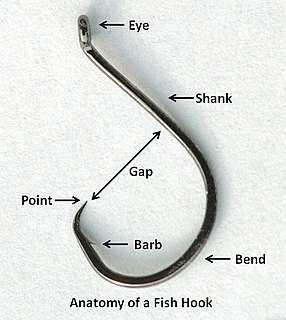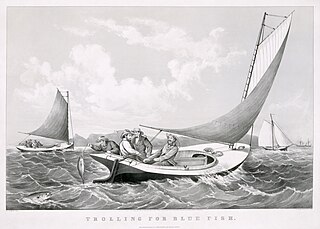
Trolling is a method of fishing where one or more fishing lines, baited with lures or bait fish, are drawn through the water. This may be behind a moving boat, or by slowly winding the line in when fishing from a static position, or even sweeping the line from side-to-side, e.g. when fishing from a jetty. Trolling is used to catch pelagic fish such as salmon, mackerel and kingfish.
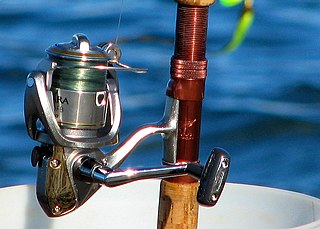
A fishing reel is a cylindrical device attached to a fishing rod used in winding and stowing line.

A fishing line is a cord used or made for angling. Fishing line is strong like, but not string. Important parameters of a fishing line are its length, material, and weight. Factors that may determine what line an angler chooses for a given fishing environment include breaking strength, knot strength, UV resistance, castability, limpness, stretch, abrasion resistance, and visibility. Most modern lines are made from nylon or silk.

Fly fishing is an angling method in which an artificial "fly" is used to catch fish. The fly is cast using a fly rod, reel, and specialized weighted line. Casting a nearly weightless fly or "lure" requires casting techniques significantly different from other forms of casting. Fly fishermen use hand tied flies that resemble natural invertebrates, baitfish, other food organisms, or "lures" to provoke the fish to strike.
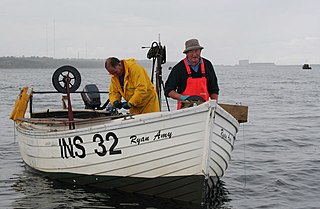
Longline fishing, or longlining, is a commercial fishing technique. It uses a long line, called the main line, with baited hooks attached at intervals by means of branch lines called snoods. A snood is a short length of line, attached to the main line using a clip or swivel, with the hook at the other end. Longlines are classified mainly by where they are placed in the water column. This can be at the surface or at the bottom. Lines can also be set by means of an anchor, or left to drift. Hundreds or even thousands of baited hooks can hang from a single line. Longliners – fishing vessels rigged for longlining – commonly target swordfish, tuna, halibut, sablefish and many other species.
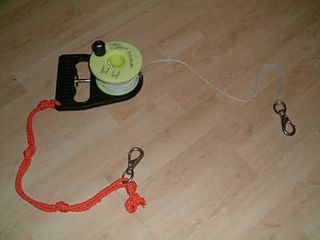
A distance line, penetration line, cave line or guide line is an item of diving equipment used by scuba divers as a means of returning to a safe starting point in conditions of low visibility, water currents or where pilotage is difficult. They are often used in cave diving and wreck diving where the diver must return to open water after a penetration when it may be difficult to discern the return route. Guidelines are also useful in the event of silt out.

A fishing lure is a type of artificial fishing bait which is designed to attract a fish's attention. The lure uses movement, vibration, flash and color to bait fish. Many lures are equipped with one or more hooks that are used to catch fish when they strike the lure. Some lures are placed to attract fish so a spear can be impaled into the fish or so the fish can be captured by hand. Most lures are attached to the end of a fishing line and have various styles of hooks attached to the body and are designed to elicit a strike resulting in a hookset. Many lures are commercially made but some are hand made such as fishing flies. Hand tying fly lures to match the hatch is considered a challenge by many amateur entomologists.
A trotline is a heavy fishing line with baited hooks attached at intervals by means of branch lines called snoods. A snood is a short length of line which is attached to the main line using a clip or swivel, with the hook at the other end. A trotline can be set so it covers the width of a channel, river, or stream with baited hooks and can be left unattended. There are many ways to set a trotline, with most methods involving weights to hold the cord below the surface of the water. They are used for catching crabs or fish. Trotlines should be used with caution as they are illegal in many states.

Rock fishing is fishing from rocky outcrops into the sea. It is a popular pastime in Australia and New Zealand. It can be a dangerous pastime and claims many lives each year, although this may improve as more fishermen are beginning to wear life jackets.

A spinnerbait is any of a family of fishing lures that get their name from one or more metal blades shaped so as to spin like a propeller when the lure is in motion, creating varying degrees of flash and vibration that mimic small fish or other prey. The two most popular types of spinnerbaits are the "in-line spinner" and "safety pin" spinnerbaits, though others such as the "tail-spinner" also exist. Spinnerbaits are used principally for catching predatory fish such as perch, pike and bass.

The Palomar knot is a knot that is used for securing a fishing line to a fishing lure, snap or swivel.

Fishing tackle is the equipment used by anglers when fishing. Almost any equipment or gear used for fishing can be called fishing tackle. Some examples are hooks, lines, sinkers, floats, rods, reels, baits, lures, spears, nets, gaffs, traps, waders and tackle boxes.

In the United Kingdom and Ireland coarse fishing refers to angling for freshwater fish which are traditionally considered undesirable as a food or game fish. Freshwater game fish are all salmonids—most particularly salmon, trout and char—so generally coarse fish, also known as rough fish, are freshwater fish that are not salmonids. There is disagreement over whether grayling should be classified as a game fish or a coarse fish.
Braided line was one of the earliest types of fishing line, and in its modern incarnations it is still very popular in some situations because of its high knot strength, lack of stretch, and great overall power in relation to its diameter. Braids were originally made from natural fibers such as cotton and linen, but natural fiber braids have long since been replaced by braided or woven fibers of a man-made materials like Dacron, Spectra or micro-dyneema into a strand of line. Braided fishing lines have low resistance to abrasion, sharp objects can easily cut braided line. Their actual breaking strength will commonly well exceed their pound-test rating.
A sabiki or flasher rig is typically fished off boats, piers, jetties, or any structure over the water. Sabikis consist of any number of small hooks, each one on individual dropper lines which are a few inches long. The individual dropper lines are then tied to a longer leader in series, about 6 inches (15 cm) apart; a weight is tied to the end of the leader. The individual hooks are decorated as lures or tied like flies similar to those used in fly fishing. Often they have a simple piece of lumo-infused material or iridescent film attached to them. Traditionally, on any individual rig, all of the lures will be either identical or in an alternating sequence of colors. The type or size sabiki used depends on water conditions, species of fish sought or simply the angler's preference.

A fishing swivel is a small device consisting of two rings connected to a pivoting joint. The device is usually made of metal, and the pivoting joint is usually ball- or barrel-shaped. The line from a rod and reel is tied to one end, and a length of fishing line, often terminated by a hook, lure or sinker, is tied to the other. The main purpose of the swivel is to allow the line to untwist during line retrieval, preventing undesirable tangling. This is particularly important for users of monofilament test line.
A pellet waggler is a small, dumpy, float used for fishing. It is suited for any small particle baits, but can also be used for larger baits such as cut cubes of meat. Its main use is to present a bait near the surface of the water, usually in the top 60 cm. When fishing deeper than 60 cm it is better to fish with a normal waggler.
Drop shotting is a high finesse technique for fishing plastic baits, and consist of a small thin-wire hook with a weight attached to the tag end of the line. This is in contrast to the more traditional Texas Rig, where the weight slides inline, resting on the nose of the bait, or the Carolina Rig, where the weight is fixed above the bait. The drop shot rig provides the ability to keep a lure off the bottom, with weightless action. Usually the bait is fished by letting the weight hit the bottom and then shaking the lure by twitching the rod. But can also be flipped, dragged, hopped, or jigged along the bottom. This simple, but versatile technique has endless combinations with the different hooks, soft plastics and weights that can be used.[1] The aim is to present a free floating, slow twitching lure to induce a strike from non-aggressive fish.This rigs known use is in bass fishing commonly used for catching Smallmouth Bass, Largemouth Bass, and Spotted Bass. But can also be used for a variety of other fish species.
The knotless knot is a hitch knot used to attach an eyed fishing hook to fishing line while leaving a length of line hanging below the hook. The extra length of line can then be used as the hair of a hair rig.
Kite fishing, a fishing technique, involves a kite from which hangs a drop line attached to a lure or bait. The kite is flown out over the surface of a body of water, and the bait floats near the waterline until taken by a fish. The kite then drops immediately, signaling to the fisherman that the bait has been taken, and the fish is then hauled in. Kites can provide boatless fishermen access to waters that would otherwise be available only to boats. Similarly, for boat owners, kites provide a way to fish in areas where it is not safe to navigate - such as shallows or coral reefs, where fish may be plentiful.


